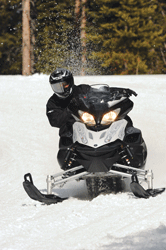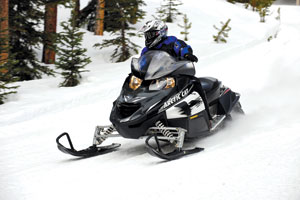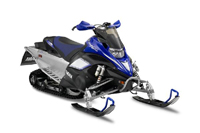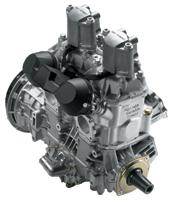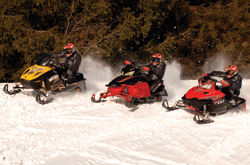The 600-class snowmobiles are the machines that matter most to snowmobile enthusiasts and manufacturers. This is proven by the fact that more sleds from this engine class are sold every year than any other class. And you can bet that each sled builder hopes you’ll buy their snowmobile so they can claim a bigger piece of the sales pie.
Ski-Doo and Polaris have led the class the past few years while regularly refining their entrants since 2006. Arctic Cat returns to our shootout after a one-year hiatus and Yamaha has a new 600-class four-stroke bred from racing.
Does the new-generation F6 Sno Pro have high-performance Arctic Cat genes? Can the 600 Dragon’s solid foundation hold its ground against the sexy new MX Z 600 X? Is the FX Nytro RTX even in the same league as the two-strokes?
The Machines
Two sleds are all new, the other two have been refined for 2008. Here are the details on what puts these snowmobiles in the high-performance class.
600 Dragon IQ
Polaris’ 600 HO CFI IQ was last season’s winner of our shootout. The company made a few changes and gave it a new badge for 2008. The 600 Dragon’s most important upgrade is its pair of new RydeFX Air 2.0 shocks up front.

Another upgrade is a new spindle that reduces steering effort. The rear suspension has new 7.25-inch diameter idler wheels for less roll resistance against the 1.25-inch Rip Saw track. The rear shock is a RydeFX compression-adjustable coil-over shock with a remote reservoir. The front damper is a non-adjustable RydeFX.
A new Freestyle seat is wider than last year’s Dragon cushion. Drivers command the machine through new flat bars connected to a 5.25-inch riser. Hand guards and Dragon graphics complete the package. Polaris lists the 600 Dragon IQ at 476 pounds.
MX Z 600 H.O. SDI X
About the only thing that isn’t new on the 2008 MX Z 600 X is its 593cc semi-direct injected engine and some miscellaneous hardware. The new REV-XP represents a complete re-design of Ski-Doo’s wildly successful REV-based MX Z.
This 418-pound MX Z X package has take-apart HPG clicker front shocks. The new SC-5 rear end has an aluminum HPG take-apart aluminum center shock and a C-36 clicker rear shock. This sled also rolls on a Rip Saw track with 1.25-inch lugs, but it’s Ski-Doo’s exclusive, lightweight 120-inch version.
The package is available in a yellow or black/slate color scheme. Fast-guy extras include a racer handlebar with hooked ends, riser block, hand guards and a low windshield.
Another unique feature is the new gauge package. The standard package included on the X models has an analog speedo and tach with an LCD screen that can display speed, engine rpm, top speed, average speed, maximum rpm and fuel economy. An altimeter, compass and record mode are optional.
Arctic Cat F6 Sno Pro
Cat engineers moved each of the F6’s swaybar mounts about an inch closer to the skis and slipped in a softer swaybar. This is meant to reduce body roll and make the machine more stable, especially through rough corners.
The F6 Sno Pro package includes Fox FLOAT ski shocks. The Slide Action skidframe has Fox dampers with a standard internal floating piston shock in front and a tougher 2-inch diameter damper on the rear torque arm.
“Sno Pro” also means the sled has an adjustable seat and handlebars, a low-cut windshield and a 15- by 128- by 1.25-inch Cobra track. The new Deluxe gauge includes an altimeter. This is the first year we’ve compared the Twin Spar-based F6 Sno Pro head-to-head with the others.
A weight spec is not published for the 2008 model, but the 2007 F6 Sno Pro was listed at 495 pounds. Updates for this year shouldn’t significantly affect the machine’s weight.
Yamaha FX Nytro RTX
Like Ski-Doo, Yamaha’s entrant in our 600-class shootout is new from the ground up. It starts with the new FX chassis and Dual Shock Pro skidframe.
The rear suspension is a two-shock, torsion spring design with coupler blocks. A set of 1.5-inch diameter compression/rebound clicker shocks dampen the skidframe that sports 14.5 inches of travel. Fox FLOAT shocks handle the holes up front with 9 inches of travel.
This sled is powered by an all-new engine that outclasses the 600cc two-strokes in terms of power output. Yamaha rates the fuel-injected, 1049cc triple at 130 hp; the smokers are in the 120 to 125 hp range. To make the engine behave more like a two-stroke, technology reduces engine braking when a driver lets off the throttle.
Along with the chassis comes new styling and ergos. The Nytro’s cab and firm seat are sculpted for comfort and easy navigation during aggressive riding. Hand guards protect the driver from roost and wind that otherwise would have a clear path to the fingers. The FX Nytro RTX with reverse is listed at 520 pounds.
Sweeper Trail
We ran a 5-mile section of Colorado mountain trail over and over again to find out which sled ruled when pushed to speeds more than 50 mph. (OK. The trail was dang fun, which is also why we ran it a dozen-or-so times over one afternoon.) Engine performance and high speed handling were important here.
The trail was about 50 feet wide and averaged two or three hi-vis sweeping corners per mile. Some stretches were mostly straight for nearly a mile; all of the trail had a gradual drop — or climb, depending on the direction we were heading.
The trail was mostly smooth, but some corners had braking bumps leading into the turns, mild ruts coming out and slight berms along some of the outside edges. Snow was soft and wet under the warm, bright sun.
Every curve on board the MX Z made us feel like we were coming through turn 4 at the Eagle River Derby Track in Northern Wisconsin. It carved quickly and precisely where the skis were pointed and stuck to its line at any speed.
Coming into the sweepers, the cut-out side panels let us set up for the turn by sliding our shin into the gap and set our body lower and farther forward than we ever have. Why did it take until 2008 for this feature to become part of a production snowmobile?
The front end is more stable compared to a REV, but much like the first rider-forward chassis did, the XP’s skis get crossed up through turns with anything more than small washboard bumps and moguls.
The Rotax engine is now five years old, but it can still run with the Polaris and the new Yamaha. With the sled’s massive weight loss, it’s more competitive. Our sample was a clean runner up top and had the power to shoot a wet, sloppy, high-speed roost into the face of those who followed too closely. Unfortunately, it had a lazier bottom end than we’re used to from this motor. Riding at about 8,500 feet above sea level affected its power output, but nonetheless, all riders noted the engine’s anemic low end.
The Dragon’s crisp, 600 CleanFire engine proved it’s still the most-fun two-stroke powerplant in the class. A revised fuel map for 2008 makes it feel stronger than last year. It was responsive, powerful and it pulled hard. Clutching was spot-on from engagement all the way through its wide-open twist of 8000 rpm. When it was time to slow down, the Phantom brake worked better than the rest at effectively and smoothly slowing the machine without locking the track. Handling is another spot this sled shines.
The Dragon cornered the flattest of the group. Even when we came into a corner too hot, the chassis stayed flat and controllable as we corrected our path and steered it through the turn. The handlebar, seat and gas tank were comfortable and allowed easy mobility for quick side-to-side weight shifts.
The front suspension was compliant over the bumps and stayed connected to the ground. Rear suspension calibrations proved to be too firm in some cases. One tester said he felt a few hard jolts when entering a corner at high speed.
Smooth, linear and powerful describe the FX Nytro RTX’s new motor. Its 5 to 10 hp advantage over the other powerplants was obvious, especially as we went up in elevation.
The engine has good low-end torque — especially within the first 30 or 40 feet out of a corner — and it kept pulling on top. When we were on the high side of 70 mph, it pulled so hard that we wished for longer straightaways.
Our timing to ride this trail when the snow was soft and wet played in the Nytro’s favor. The machine handled very well and flowed predictably through turns when the snow was soft. If snow was icy and set up, the Yamaha hunted, darted, lifted its skis and handled poorly.
The first thing we’d do to a Nytro is install a different set of skis, but finding the right set might take some trial and error because it reacted drastically different in varied snow conditions.
Perhaps setup changes would make it work better on a hardpacked trail, but would that make it suffer on loose trails? Owners will need to learn what to change and how much adjustment is needed to keep this sled working well in all conditions.
This trail’s high-speed sweepers is where the F6 Sno Pro performed its best. It was more predictable and controllable than in tight trails or through rough sections. We could let the inside ski tip up to plant the outside in place. The FLOAT-equipped front suspension is a little tippy, so it’s easy to do. The skis pushed if we kept the front end flat.
Body transitions required some drivers to lift their butts off the seat to get from one edge of the seat to the other. This takes precious time and might leave a rider unprepared when approaching a corner. Seat cushioning is too wide and protrudes too far forward for riders to lock in the cab with their knees. This seat is suited more for sightseeing than aggressive riding.
Power is one spot where the Cat lags far behind the other sleds. The party took a few seconds to get re-started if we dropped below mid throttle because the engine has zero low-end grunt.
The powerplant worked OK once we reached beyond mid-digit speeds, but the machine also lagged up top because it’s heavier than the other two-strokes. Put simply, Cat needs a strong, new 600 to be competitive in this class (we expect this for 2009 or perhaps as a late-release 2008).
Tighter And Twistier
Not all of Grand Lake’s snowmobile trails are wide and fast. We ripped this fleet of 600-class sleds through technical trails, too. This gave us a good feel for each machine’s handling and power delivery in tight sections, their responsiveness to driver input and ergonomics. This is where the new MX Z proved that a lightweight sled is more entertaining and easier to drive.
One tester said the REV-XP was the most fun he’s ever had on a 600. Cornering was faster and corrections were easier to make. The sled was easier to manipulate through technical sections than the other machines because of its on-average 79-pound advantage.
The machine is responsive and feels small, nimble and light. Side-to-side transitions are easy and comfortable; the seat height and gas tank shape make it easy to prepare for tight corners that sneak up on drivers. The seat cover has good traction to hold drivers in place yet it slips just enough so they can move around.
Much like it did on the big trail, bottom-end engine performance from the MX Z suffered here, too, but it livened up once we got through each corner and engine rpm increased. The engine occasionally gurgled on the low end when we rode it aggressively over rough terrain.
Cat’s Suzuki engine showed its weakness here. We usually had enough room to crank up the machines to about 50 mph before we had to let off for the next turn. Without any snap down low, we couldn’t sling from corner to corner like the Polaris, Yamaha or even the lazy Ski-Doo would.
Perhaps clutch calibrations weren’t right, but 2008 represents the 600 Laydown’s fifth season on the snow — and the second year in the Twin Spar chassis — so we assume the Cat staff has calibrations figured out for the elevation where we tested. This engine was downright flat at lower rpm and simply smoked by the other 600-class options.
Ergonomics are more comfortable than the Firecat chassis it replaced two years ago. The wide and soft seat certainly would be the best for a 300-mile day. The adjustable handlebars felt solid when clamped down and provided a comfortable setting for every rider. Steering the Cat took the least effort of all machines, but the sled pushed through turns.
The Sno Pro’s rear end worked well over stutter bumps. This was another spot where the Firecat-based Sno Pros lagged because they weren’t calibrated with enough suspension progression. The new version was more supple and we could use all of its travel.
The Dragon diced through the woods with precision and it inspired truckloads of confidence. It took minimal effort to go fast and steering effort was a non-issue thanks to the new spindle. Good ergonomics let us navigate around the fuel tank and lean into corners quickly.
Small stutter bumps are where the Polaris has improved due to the new RydeFX Air 2.0 shocks. The skis skimmed over the bumps without transferring impact or chatter to the driver. It was a good balance of compliance and control that makes the chassis feel so good.
The rear suspension was too stiff over those same bumps. Softer low-speed valving in the rear shocks would let the shock compress farther into its stroke and reduce the harsh feel.
The Nytro has a unique feel from the cockpit. One rider said he felt as though he was steering the machine from above the spindles, as if the bars are too high and too far forward. He couldn’t round off the corners and instead had to point and shoot the sled from turn to turn.
The Yammie responded well to driver positioning and it handled better than any other four-stroke Yamaha to date in soft snow. It handled flat, but it would pitch to the outside like previous blue four-strokes when crossing other ruts. If this happens, the four-stroke weight becomes more noticeable and it’s more difficult to correct than a two-stroke.
The Genesis 130FI engine’s low-end torque played well when we were on and off the throttle. The broad four-stroke power seemed to transmit just the right amount of juice to make the sled accelerate hard without breaking the track loose.
Big Bumps
Top performance in the big moguls came from two sleds: the Dragon and the MX Z. The Nytro put up a surprisingly good performance worthy of second place (or third, depending on whether you’re an optimist or a pessimist).
When it comes down to the Dragon and MX Z’s ability to absorb bumps, they’re darn close. Go ahead and hit anything, the machines don’t care. We repeatedly slammed through a 500-yard section of firm, 2- to 3-foot snowdrifts at wide-open throttle without a hint of losing control.
The MX Z worked best for a 155-pound rider with the IFS springs cranked up to full stiff; the Dragon was in its best form with the torsion springs set on medium. We felt some tail swap from the MX Z, but it was controllable. The Dragon seemed to tip, but it, too, was controllable.
Stability is one thing that increases with more weight. The Dragon is the most stable and predictable machine for bombing down a trail with nasty chop and sharp-edged, 1- to 2-foot moguls. If a driver’s goal is to quickly get from point A to point B over rough trails, the Dragon is our No. 1 pick.
It can be pushed as hard and fast as a driver wants to push it over the nastiest trails and the sled will react how he expects. This became especially obvious when we moved to a trail’s outer edge to avoid the big moguls in the center.
We could ride the Dragon there with more confidence and higher speeds than the MX Z. The yellow sled felt light as a corn flake, but the front suspension felt harsh on some hits — partially because there’s less mass between the skis and the rider to absorb the impact. Look for this to improve after Ski-Doo suspension engineers get another season or two to tune the shocks with the chassis.
The IQ felt tight and solid as it skipped over the bumps, but when switching from the REV-XP, it felt heavy. The biggest disappointment of the Dragon in the rough was its lack of foot traction. Ski-Doo raised the bar with its super-duty cheese graters integrated in the REV-XP tunnel.
With the baggage caused by lackluster big-bump performance from the first-generation Nytro weighing heavily on our minds, we were skeptical whether the 2008 model would be able to pound through the moguls like Yamaha claimed it could.
Fortunately, the FX Nytro RTX worked better than we expected through the moguls and rough trails. The chassis stayed flat and controllable as suspensions swallowed the holes. If it got off kilter in mid-air, we could tug it back on course by pulling on the bars or shifting our weight.
Without question we could feel the machine’s mass, but it performed well in the big-uns if we kept the front end up. The strong low-end grunt from the Genesis 130FI engine helped that.
Our 155-pound rider made it through the drift section without bottoming the skidframe, but a 190-pound tester said it felt too soft even after he cranked up the torsion springs. The same rider said the front end was too rigid, but unfortunately we didn’t have an air pump to adjust the Fox FLOAT shocks.
Each rear shock has 20 clicks of rebound and 12 clicks of compression adjustment. Sadly, field adjustments on the Yamaha dampers are a pain; the clickers are difficult to access and if you succeed at making a change, it’s nearly impossible to know where the shock is in its range of adjustment.
With just one afternoon to compare the machines side by side, we couldn’t afford the time to study and adjust the Nytro’s shocks. More daylight and an air pump would have been a luxury. We stuck with simple torsion spring changes.
The F6 Sno Pro felt longer and bigger than the others over large moguls. The tunnel’s steep upward angle nearly made us feel like we were being pushed forward when standing.
There was more rear-axle hop and hangups than the other machines due to the Twin Spar chassis’ longer wheelbase. It kicked from the rear axle, too, but its cause wasn’t clear. Was it the longer track or was the shock rebound too quick?
The Slide Action suspension worked OK. It didn’t do anything extraordinarily well, but it wasn’t bad, either. It bottomed easier than the others and let out a wicked “crunch” when it hit hard. Fortunately, the suspension kept the sled in control without pitching us like the skinny Firecat skidframes did. The Sno Pro flew relatively flat and straight.
In Your Garage
Snowmobilers work on their sleds, so we evaluated each machine for its ease of routine maintenance, fit and finish.
Polaris’ IQ is one of the last sleds to be built with a traditional tub and tunnel layout that’s covered by a hood/headlight assembly. It’s as familiar as grandma’s Christmas goose and there’s easy access to the engine, spark plugs, oil and coolant reservoirs. Its side panels are difficult to install and they popped out of place over rough terrain during our test. The hood fell out of place, too. The drive belt easily removes from the secondary clutch with a tool, but it gets stuck between the primary’s moveable sheave and the side panel. Chain lube can be conveniently checked through a small sight glass.
When we stepped back and looked at the sleds side-by-side, the Nytro gives the perception that it has the best fit and finish. The Yamaha is also the most complex and intimidating. Our experience with the machines makes us think that Yamaha wants its sled owners to leave all maintenance and repairs up to their dealer. With the hood and side panels removed, lots of “stuff” was still hidden under other plastic shrouds. Yamaha’s four-strokes require less maintenance, arguably, but they can still foul a spark plug or blow a belt. Engineers should design easier access. The adjustable brake lever actuation is a nice, customizable touch.
Ski-Doo’s REV was well-designed for accessibility, and the new XP seems to have been, too. The oil injection reservoir has increments that provide an easy way to check the level at a glance without turning a key or making a guess at a tapered container. The recoil handle is tucked away, but like the REV, the rope rubs the side panel when it’s pulled and makes it look shabby. It should have been made out of a burn-resistant material. IFS shocks are small and contain less fluid than a larger shock, which could make them more prone to fade. The rear suspension is a simple design and its rebuildable shocks appear easy to remove.
It seems that some of the F6 Sno Pro’s positive traits were offset by a negative. The sled has a big trunk that holds more stuff than a college dorm room. Unfortunately, it’s too bulky and busy for a performance sled. The snow flap was effective to prevent snow spray, but it’s too complex and gives the perception that it’s broken. The mount bolts fit loosely and the slot where it’s designed to bend is flimsy. The side panels fit well and lock in place, but the bottom rubber strap is thin and might not hold up more than a few seasons. If owners open the panel on the trail, they should make sure the channels are clear of snow and ice to get a secure fit.
A Tough Decision
Each sled has its strong points. The Arctic Cat might be the best high-mileage sled of the bunch. The F6 Sno Pro is comfortable and refined with a wide seat and comfortable ergos, but it’s bulky and its handling is dull. A new engine could improve the sled, but to be taken seriously in the high-performance class again, Cat will need a new lightweight chassis, too.
After building several variations of so-called rough-trail four-stroke sleds over the past few seasons, Yamaha now has a legitimate contender against the others in the 600 class. After conducting this test, we’re convinced that a four-stroke snowmobile can compete with the two-strokes. The FX Nytro RTX needs suspension and handling refinement to move past third place, though.
None of our testers can identify a reason not to own a 600 Dragon. It performs well in all situations and it’s a comfortable, stable machine with the most-capable suspension and engine package. Unfortunately for Polaris, the Dragon doesn’t have the sporty feel and sex appeal of the new MX Z.
The Ski-Doo and Polaris’ performance was close and all judges had a tough time picking a winner. But the MX Z’s fun and hard-core, sporting image and industry-changing weight loss program make it our 2008 High-Performance 600-class Shootout champion.

